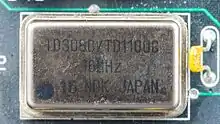Nihon Dempa Kogyo
Nihon Dempa Kogyo Co., Ltd. or NDK (日本電波工業株式会社, Nihon Dempa Kogyo Kabushiki-gaisha) is one of the world's largest quartz crystal companies, based in Shibuya, Tokyo, Japan.
 | |
Native name | 日本電波工業株式会社 |
|---|---|
| Type | Public (K.K) |
| TYO: 6779 | |
| ISIN | JP3737800007 |
| Industry | Electronics |
| Founded | April 1948 |
| Headquarters | Sasazuka, Shibuya-ku, Tokyo 151-8569 , Japan |
Key people | Toshiaki Takeuchi (Chairman of the Board, President and CEO) |
| Products |
|
| Revenue | (US$ 386 million) |
(US$ -2.2 million) | |
Number of employees | 3,419 (consolidated, as of September 30, 2018) |
| Website | Official website |
| Footnotes / references [1][2][3] | |
Using its synthetic quartz crystals, NDK produces crystal-related products such as crystal devices (e.g. crystal units, crystal oscillators, crystal filters) and ultrasonic transducers for medical use. In recent years, the company has begun to develop frequency synthesizers and low-power wireless modules.
History
- 1948 : NDK was established.
- 1950 : Started crystal unit production and sales.
- 1958 : Succeeded in test production of synthetic quartz crystal.
- 1959 : Started crystal filter production.
- 1960 : Started crystal oscillator production.
- 1963 : Began trading of NDK stock on the OTC market.
- 1979 : Developed and industrialized surface acoustic wave (SAW) filter.
- 1990 : Listed NDK stock on Second Section of the Tokyo Stock Exchange.
- 1998 : Listed on the First Section of the Tokyo Stock Exchange.
- 2009 : US manufacturing plant blew up with loss of life.
Products
- Crystal Units
 Crystal Clock Oscillator NDK TD308C/TD1100C
Crystal Clock Oscillator NDK TD308C/TD1100C - Crystal Oscillators
- SPXO
- TCXO
- VCXO
- OCXO
- Crystal Filters
- Surface Acoustic Wave (SAW) Devices
- Optical Components
- Synthetic Quartz Crystals
- Ultrasonic Transducers
- Frequency Synthesizers
Company locations
NDK has sales offices in Japan, China, France, Germany, Italy, Malaysia, Singapore, United Kingdom, and United States. NDK has production and engineering facilities in Japan, China, Germany, Malaysia, and the United States.
NDK's Belvidere, Illinois facility was heavily damaged in 2009 when one of the crystal autoclaves ruptured violently, causing an explosion. A beam from the NDK building killed a man at a nearby gas station, and a shard of the ruptured autoclave's wall injured two others and caused heavy damage in a nearby office building.[6] The rupture was in a crystal-growth autoclave that had undergone stress corrosion cracking and was inadequately inspected; recommendations from a previous incident were ignored. As a result, the autoclave became overstressed and failed completely.[7] Demolition of the facility began in March 2015.[8]
References
- "Profile". Nihon Dempa Kogyo. Retrieved May 16, 2019.
- "About the company". Financial Times. Retrieved May 16, 2019.
- "Company Profile". Nikkei Asian Review. Nikkei Inc. Retrieved May 16, 2019.
- David Manners (June 15, 2015). "NDK uses quartz to detect disease from breath". Electronics Weekly. Metropolis International. Retrieved May 17, 2019.
- Masahide Kimura (June 14, 2015). "New disease-sniffing sensors promise quick, simple diagnosis". Nikkei Asian Review. Nikkei Inc. Retrieved May 17, 2019.
- Rolf K. Eckhoff (June 14, 2016). Explosion Hazards in the Process Industries. Elsevier Science. p. 173. ISBN 978-0-12-803274-9.
- "CSB Finds Fatal 2009 NDK Explosion Resulted from Stress Corrosion Cracking of High-Pressure Vessel". U.S. Chemical Safety and Hazard Investigation Board. November 14, 2013. Retrieved May 16, 2019.
- "NDK Tower Being Demolished". WIFR-LD. Gray Television. March 12, 2015. Retrieved May 16, 2019.
External links
- Official website (in English)